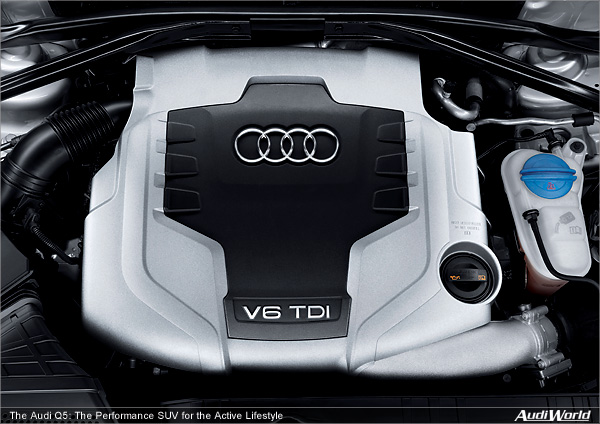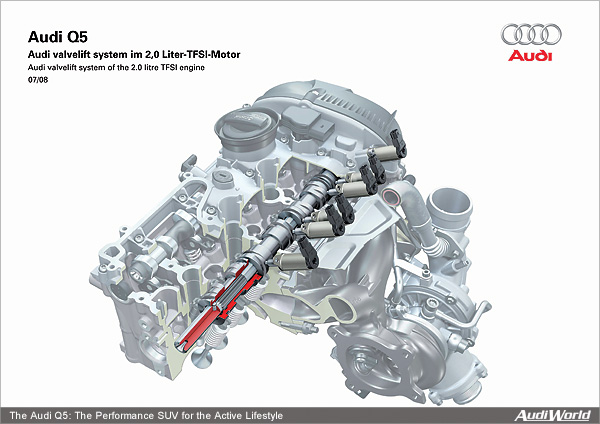Audi Q5: The Engines

Gasoline direct injection, badged as FSI, is a competition-beating technology, especially when paired with turbocharging. On the 2.0 TFSI, a newly developed common rail system injects the fuel directly into the combustion chambers at a pressure of 150 bar through six-hole injectors; flaps in the intake tract induce a specific swirl pattern. The temperatures are reduced by its evaporation, overcoming the age-old problem of turbo technology the high amount of heat it generates and therefore the tendency to knock. Despite the presence of turbocharging, Audi’s engineers achieved a high compression ratio of 9.6:1 that plays a big part in its combustion efficiency.
Audi’s gasoline direct injection concept first supplied evidence of its potential in June 2001. It was then that a TFSI engine powered the Audi R8 sports prototype to overall victory in the Le Mans 24 Hours; 64 more victories out of 80 starts followed in subsequent years.
This technology notched up a string of successes in road cars, too the 2.0 TFSI has been voted “Engine of the Year” four times in succession by an international jury of journalists since 2005.
New development: the 2.0 TFSI
The new 2.0 TFSI in the Audi Q5 is the successor to this winner; Audi has thoroughly reengineered it, while retaining the same basic dimensions. Like its predecessor, it has a displacement of 1,984 cm3. Its two balancing shafts in the crankcase compensate the free second-order inertial forces and lead to refined running with very low vibrations. All components have been optimized for minimal friction, above all around the cylinder bores and conrod bearing shells. The oil pump operates with volume-regulated delivery and two-stage pressure control, which likewise reduces fuel consumption.
When it comes to turbo technology, the 2.0 TFSI again represents the state of the art. A water-cooled charger increases the filling of the cylinders with air; optimized turbine and compressor wheels have improved its response. The intercooler is another new development; it combines a high degree of efficiency with low weight and compact dimensions.
The two-liter TFSI engine is equipped with the new Audi valvelift system that regulates the valve lift variably in two stages. Unlike on the 3.2 FSI in the Audi A6, here it acts on the exhaust valves. Together with the intake camshaft that can be adjusted through 60 degrees, it improves the charge cycle and further boosts pulling power. The driver experiences the AVS system as a technology designed to enhance driving fun it guarantees a spontaneous, dynamic torque buildup.
The 2.0 TFSI realizes a sporty performance of 155 kW (211 hp) and 350 Nm (258.15 lb-ft) of torque, the latter from as low as 1,500 rpm right up to 4,200 rpm. The two-liter power unit accelerates the Audi Q5 from a standstill to 100 km/h (62.14 mph) in 7.2 seconds, and on to a top speed of 222 km/h (137.94 mph). The 2.0 TFSI achieves astonishingly good fuel efficiency, managing 100 kilometers on 8.5 liters (27.67 US mpg). Its high torque allowed the developers to extend the transmission ratio somewhat an important factor in the efficiency concept.
The new 3.2 FSI will step into the role of top gasoline engine in the new Audi Q5 at the start of 2009. It combines a whole raft of hi-tech features the innovative Audi valvelift system for valve control, FSI gasoline direct injection and a variety of measures to reduce internal friction and therefore further enhance efficiency.
The 3.2 FSI develops 195 kW (270 hp) from a displacement of 3197 cm3, and its ample maximum torque of 330 Nm (243.40 lb-ft) is achieved constantly from 3,000 to 5,000 rpm. It accelerates the Audi Q5 3.2 FSI from 0 to 100 km/h (62.14 mph) in approximately 6.8 seconds (provisional figure) and on to a governed top speed of 232 km/h (144.16 mph).
This impressive power flow is achieved on exceptionally little fuel consumption reaches only approximately 9.3 liters/100 km (25.29 US mpg) on the 3.2 FSI with manual transmission (provisional figure). The Audi valvelift system has played a major part in this progress in fuel efficiency the new valve control technology reduces fuel consumption by a good five percent. The Audi valvelift system, where valve lift is controlled variably in two stages, assures excellent filling of the combustion chambers in every situation.
It regulates the amount of air drawn in when the intake valves open; the throttle valve can usually remain fully open, thus largely eliminating undesirable throttling losses. The engine is able to breathe freely, and achieves higher output and torque on less fuel.
Economical and refined: the TDI engines
For almost 20 years, Audi’s TDI engines have been setting the standards in their field. In 1989 Audi introduced the TDI principle, and since then the brand with the four rings has steadily extended its lead. With their high torque, good fuel efficiency and quiet, refined running these diesel concepts create a harmonious and convincing overall impression a modern, smart form of sportiness. In the three victories of the R10 racing car at Le Mans from 2006 to 2008, Audi has demonstrated what power the TDI harbors.
The V6 TDI engine in the Audi Q5 is from the Audi V engine family, which features a 90-degree included angle between the cylinder banks. Its compact engine block is made from light but very strong vermicular graphite cast iron.
Intensive fine tuning measures have minimized friction losses: the pistons are fitted with optimized rings, and the chain drive for the camshafts and the injection pump have also been intensively revised. The new oil pump with volume-regulated delivery draws much less power from the engine than its predecessor component.
Ultra-precise: the common rail injectors
The third generation of common rail systems with eight-hole nozzles is used. The high pressure of up to 1,800 bar equivalent to the entire weight of a car resting on a surface the size of a finger nail assures extremely fine atomization of the fuel and therefore precise mixture formation and combustion. The injectors use the piezo principle, which applies an electrical voltage to a ceramic element. This alters its crystalline structure; the material’s expansion is translated into movement that operates the injector needles.
The injectors are extremely fast-acting and close again within one to two milliseconds, thus permitting minute injection quantities of just 0.8 of a milligram. They can vary the number of injection processes per operating cycle across a wide range; up to five injection operations are possible. This strategy reduces emissions and produces a smooth combustion process, so that the engine’s noise pattern is also more satisfactory. The three-liter diesel is the best performer in its class in terms of refinement.
The 3.0 TDI uses the latest design of VTG turbocharger, with variable turbine geometry. In the interests of a spontaneous torque buildup, a fast-acting electric actuating motor adjusts its vanes.
The intercooler, also a new feature, is installed transversely ahead of the radiator in an ideal position for optimal cooling, and has a high thermal efficiency rating. Cooling of the compressed air increases the level of oxygen required in the cylinders for the combustion process.
The modified 3.0 TDI is notable for its particularly clean exhaust emissions it already provisionally complies with the limits of the future Euro 5 standard. A new concept for the recirculation of cooled exhaust gas drastically reduces emissions of nitrogen oxides.
A diesel particulate filter is used to reduce soot emissions: it cuts the already low level of untreated emissions further, by more than 90 percent. The filter is located close to the engine, so only a small amount of heating energy is required for its regeneration.
Enormous thrust: 500 Nm (368.78 lb-ft) at 1,500 revs
The three-liter diesel develops 176 kW (240 hp). Its peak torque is an impressive 500 Nm (368.78 lb-ft); the driver has this on tap right across the range from 1,500 to 3,000 rpm. This is the key to the surge of power a wave on which the car, like a surfboard, is carried forward in a relaxed, carefree way. The powerful TDI with an engine capacity of 2,967 cm3 accelerates the Audi Q5 from 0 to 100 km/h (62.14 mph) in only 6.5 seconds and reaches a top speed of 225 km/h (139.81 mph) at an average fuel consumption of only 7.7 l/100 km (30.55 US mpg).
When engines are developed, the demands for higher power, lower fuel consumption and reduced pollutant emissions normally all clash with each other. However, with the reengineered version of the 3.0 TDI Audi has made progress with all the main parameters despite their conflicting nature further evidence of the brand’s leading position in the TDI sector.
The second diesel in the Audi Q5, the 2.0 TDI, operates even more efficiently than the three-liter version. Its average fuel consumption is a mere 6.7 liters per 100 km (35.11 US mpg). With a displacement of 1,968 cm3, the four-cylinder unit is a new interpretation of the TDI concept’s outstanding qualities. It builds on the characteristic strengths of its predecessor the world’s most-built diesel engine and offers customers even more driving fun, economy and refinement.
The area in which decisive progress has taken place is the cylinder head, where two camshafts operate 16 valves. Common rail injection controlled by one of the most modern engine management systems on the market supersedes the previous pump-injector units. The 2.0 TDI, too, has modern piezo injectors with eight-hole nozzles; the finely modulated process of up to five injection operations per operating cycle drastically reduces the noise level. The single-piston high-pressure pump develops a system pressure of 1,800 bar.
Quiet and refined: elaborate noise reduction measures
The acoustics of the toothed belt drive have also received attention, with additional noise-reducing structures on the belt cover. As on the previous engine, two balancing shafts reduce the vibration generated by the crankshaft and reciprocating parts. Various modifications were made here and at the oil sump because the 2.0 TDI is installed in the Audi Q5 inclined 20 degrees to the right.
Other special features improve the performance of the four-cylinder engine, which has a compression ratio of 16.5:1. Its turbocharger has variable vanes for a swift torque buildup; a pulsation damper reduces its vibration. Electric motors control the position of the swirl flaps in the intake manifold to adapt the incoming airflow continuously to the prevailing engine load and speed.
Optimized intake-air management and modified piston geometry result in a high maximum engine speed of 5,000 rpm and improved combustion chamber thermodynamics. They enable the two-liter TDI to operate with an exhaust gas recirculation rate of up to 60 percent; this means combustion takes place at a lower temperature and oxygen level, reducing the untreated emissions of nitrogen oxides. The EGR (exhaust gas recirculation) system achieves a high cooling performance.
The refined 2.0 TDI unit produces 125 kW (170 hp) and applies a full 350 Nm (258.15 lb-ft) of torque to the camshaft at engine speeds of 1,750 to 2,500 rpm. This is ample for accelerating the Audi Q5 to 100 km/h (62.14 mph) in 9.5 seconds and for giving it a top speed of 204 km/h.
The equipment, data and prices stated here refer to the model range offered for sale in Germany. Subject to amendment; errors and omissions excepted.
|

